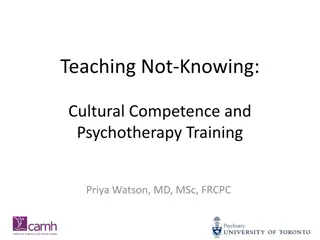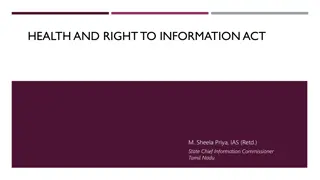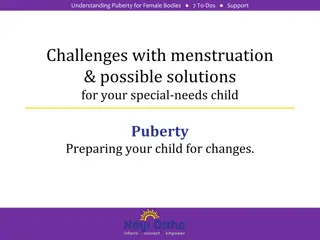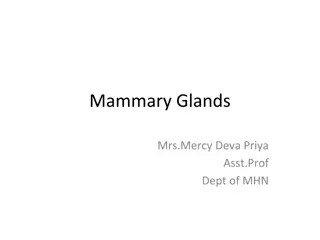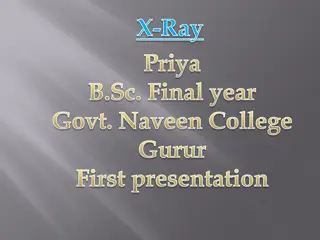
Exploring Financial Resilience: Impact of Mudra Yojana on Indian MSMEs
Discover how the Pradhan Mantri Mudra Yojana is empowering women entrepreneurs in India, enhancing financial inclusion, and supporting the growth of Micro, Small, and Medium Enterprises (MSMEs). Learn about loan categorization, the definition of MSMEs, and the significant role MSMEs play in driving economic growth. This presentation sheds light on the pivotal role of PMMY in shaping the economic landscape and fostering innovation in the MSME sector.
Download Presentation

Please find below an Image/Link to download the presentation.
The content on the website is provided AS IS for your information and personal use only. It may not be sold, licensed, or shared on other websites without obtaining consent from the author. If you encounter any issues during the download, it is possible that the publisher has removed the file from their server.
You are allowed to download the files provided on this website for personal or commercial use, subject to the condition that they are used lawfully. All files are the property of their respective owners.
The content on the website is provided AS IS for your information and personal use only. It may not be sold, licensed, or shared on other websites without obtaining consent from the author.
E N D
Presentation Transcript
WOMENS FINANCIAL RESILIENCE: A LOOK AT MUDRA YOJANAS INFLUENCE ON INDIAN MSMEs Power Point Presentation On Women s Financial Resilience: A Look at Mudra Yojana s Influence on Indian MSMEs Author Id:= Bus37161223 Presented by : Mamta Aggarwal (Assistant Professor) Meera Bamba (Associate Professor) Priya (Research Scholar)
Introduction Promotion of financial inclusion stands out as one of the paramount goals of the government, aimed to broaden the reach of financial products and services to serve the underserved and unprivileged section of the society (Thorsten, 2016). In order to pursue these goals government of India initiated Pradhan Mantri Mudra Yojana in April 2015. This program aims to provide loans up to Rs. 10 lakhs to farm, non-farm, non-corporate income- generating activities within the unit engaged in manufacturing, processing, trading and other services sector (Pathak, 2022). To facilitate the financial inclusion of women entrepreneurs in India the government s flagship programme, PMMY, has played a pivotal role within the economic landscape in India (Silas & Bodra, 2023).
Loan categorization under MUDRA yojana Shishu Kishore Tarun Loan up to Rs 50, 000 to new entrepreneur to help them in setting their business ventures Loan ranging from Rs. 50,001 to 5,00,000for the expansion and growth of already existed businesses Loan ranging from Rs 5,00,001 to 10,00,000 to very well business that required more additional funds for their further growth and expansion.
Definition of MSME The definition of MSME as per the RBI and the Government of India Gazette official notification S.O. 2119 (E) dated on June 26, 2020, are as follows: 1. A micro enterprise is an enterprise where investment in plant and machinery or equipment does not exceed Rs. 1 crore and turnover do not exceed Rs. 5 crores 2. A small enterprise is an enterprise where investment in plant and machinery or equipment does not exceed Rs. 10 crore and turnover does not exceed 50 crores. 3. A medium enterprise is an enterprise where the investment in plant and machinery Rs. 50 crore and turnover does not exceed Rs 250 crore.
Literature Review Role of MSME in economic growth 1. MSME plays crucial role in the growth and development of any economy and therefore it pivotal to protect, promote and develop them for the sustainable growth of the country (Das, 2008). In the context of developing country like India, MSME contributes more than 50% of the total output among the manufacturing sector (Ali & Husain, 2014). To enhance the efficiency and the competitiveness, government should take measures for productivity improvement, quality enhancement and cost reduction (Lama, 2012). MSME stands out as one of the most expanding sector that having significant potential in production, employment generation and exports, this sector plays a pivotal role in driving economic growth and fostering innovations (Srivastava, 2020). This serves serve as a crucial catalyst for inclusive growth, empowering the marginalized and vulnerable groups and communities (Shelly et al., 2020).
MSME and women Category Micro Small Medium All Male 79.56% 94.74% 97.33% 79.63% Female 20.44% 5.26% 2.67% 20.37% All 100% 100% 100% 100%
PMMY and Women The main problem associate with the growth and the development of women entrepreneurs is the lack of financial assistance (Agrawal et al., 2023) . To resolve the issue government of India has undertaken variety of measures such as Jan Dhan Yojana, Mudra Yojana, Sukanya Samriddhi yojana etc. Among all these initiative Mudra initiative plays a pivotal role in providing financial assistance for the growth and development of women MSMEs (Mahesh et al., 2022). It supports women entrepreneurs by providing them loan assistance without any collateral security for their socio-economic development (Kumar & Divya, 2021). financial support this initiative succeed in improving women s standard of living, rising their per capita income and reduction in poverty (R. R. Singh, 2022). PMMY performed well in promoting the new entrepreneurs under the Shishu category (Ramesh, 2016). This scheme succeed in generating more employment opportunities by providing them financial assistance to begin a new business venture (Soni, 2016). The study of Agarwal & Dwivedi (2017) analysed the performance of PMMY on the basis of caste, states and category wise. Andaman and Nicobar having negative growth trend andAssam having higher growth rate. By providing the
Research Gap Women participation in MSMEs particularly under Mudra Yojana, is relatively one of the unexplored areas in the context of India s economic growth. Limited comprehensive studies available that analyse the role of women-led MSME in the economic growth of the nation. No much studies investigate the relationship between number of accounts, loan amount sanctioned and the actual amount of loan disbursed under MUDRA Yojana. There is need to gain deeper insights related to the factors that affects the decision making and management and the gender- specific challenges that women entrepreneur encounter.
Research Objective Based on the research gap following are the proposed research objectives of the study: To examine the trend and pattern in Number of accounts owned by women-led enterprise under the three schemes of Mudra Yojana consisting Shishu, Kishore and Tarun. To assess the relationship between the number of Mudra account owned by women and loan amount sanctioned to the amount of loan disbursed Under the MUDRAYojana.
Research Methodology In order to achieve the desired objectives, secondary data related to number of women- led entrepreneur, account owned by women under MUDRA yojana, loan amount sanctioned and the loan amount disbursed from the multiple sources such as Annual report of Mudra yojana, MSME reports, Ministry of Statistics and programme implementation and the various research papers. to analyse the data various kinds and tables, charts and diagrams were utilized. To examine the relationship between the variables, this study employed correlation analysis through the SPSS 20 version by taking women owned number of accounts under Mudra Yojana amount of loan sanctioned under the account and the amount of loan disbursed.
Findings and Discussion Trends and patterns related to number of accounts owned by women under the three schemes i.e., Shishu, Kishore and Tarun Women beneficiaries under PMMY Shishu No of A/C Amount (crore) Kishore Tarun No of A/C Amount (crore) No. of A/C Amount (crore) Time period / categories 2017-18 2018-19 2019-20 2020-21 2021-22 2022-23 32144132 80371.59 1335192 33403579 96253.15 2875392 35717217 109660 27753288 74490.46 5468211 30441921 89621.66 7892778 32817496 112856.7 11285672 16586.84 26741.23 26477 50730.64 70027.9 92756.54 78914 783591 397825 82105 94560 153645 6295.7 10039.23 9045 6082.24 6772.91 11340.92 2988307
Comparative Analysis Comparitive analysis of Accounts opned under Shishu, Kishore and Tarun scheme Comparitive analysis of amount santioned under Shishu, Kisore and Tarun Yojana 40000000 35000000 120000 30000000 100000 25000000 80000 20000000 60000 15000000 40000 10000000 20000 5000000 0 0 2017-18 2018-19 2019-20 2020-21 2021-22 2022-23 2017-18 2018-19 2019-20 2020-21 2021-22 2022-23 No. of Accounts opnened under Shishu No. of Accounts opened under Kishore Amount sanctioned Under Shishu Amount sanctioned under Kishore No. of Accounts opened under Tarun Amount sanctioned under Tarun
2 to test the Relationship between the number of Mudra account and loan amount sanctioned to the amount of loan disbursed Under the MUDRA Yojana Financial PMMY No. Amount Amount % of Amount Relationship between account opened with amount sanctioned and amount disburesd Year of Accounts sanctioned disbursed disbursed to 180 opened (In (in Million) (In million) amount 160 million) (A) (B) (C) sanctioned 140 (C/B) * 100 97.15 120 2017-18 48.13 2536.771 2464.374 100 2018-19 59.87 3217.228 3118.114 96.91 80 2019-20 62.25 3374.955 3297.150 97.69 60 40 2020-21 50.74 3217.592 3117.545 96.89 20 2021-22 53.80 3391.103 3314.022 97.72 0 2017-18 2018-19 2019-20 2020-21 2021-22 2022-23 2022-23 62.31 4565.380 4504.237 98.66 % of Amount disbursed to amount sanctioned Accounts opened (In million)
This table provides the data on PMMY for multiple of the financial year, including number of accounts opened, amount sanctioned and the amount disbursed under this scheme. The number of accounts opened under this scheme has increased over the years, indicating growing participation and individual interest in this scheme. The above-mentioned table indicates a consistent growth trend in amount sanctioned and amount disbursed under MUDRA yojana with only one notable expansion during the financial year 2020-21 due to the impact of Covid-19 pandemic. This trend reflecting an expanding commitment to providing financial assistance to the entrepreneurs and individuals. However, this scheme gained much popularity, as it exhibited a positive growth throughout the period and reaching to the highest figure of total funds disturbed at Rs. 4.50 lakh crore during the current financial year 2022-23. This expansion of Pradhan Mantri Mudra Yojana initially covers only the income generating activities in manufacturing and its aligned sector.
Results of correlation analysis Correlations Amount disbursed under Mudra No. of Accounts owned Sanctioned amount under Mudra Amount disbursed under Mudra No. of Accounts owned sanctioned amount under Mudra amount disbursed under Mudra No. of Accounts owned sanctioned amount under Mudra amount disbursed under Mudra No. of Accounts owned sanctioned amount under Mudra 1.000 .704 1.000 Pearson Correlation .704 1.000 .707 1.000 .707 1.000 . .059 .000 Sig. (1-tailed) .059 . .058 .000 .058 . 6 6 6 N 6 6 6 6 6 6
Amount disbursed and number of accounts owned: Results of correlation analysis indicates a moderately strong positive correlation of 0.704 between amount disbursed and number of accounts owned, indicates that amount disbursed tends to rise with the increase in number of accounts owned. The p value 0.059 (p< 0.1) provides a marginally significant correlation between amount disbursed and number of accounts owned. Amount disbursed and Sanctioned Amount: it indicates a perfect positive correlation of 1.000, highlights a strong linear relationship between amount disbursed and amount sanctioned. As one rises, other also rises proportionally. The p value of 0.000 (p<0.05) indicates a significant correlation between amount sanctioned and disbursed. Number of Accounts owned and Amount Sanctioned: There is a moderate strong correlation persists between accounts owned and amount sanctioned. The p-value of 0.058 (p < 0.1) suggests marginal significant correlation between account owned and amount sanctioned.
Conclusion of the Study This study examined the trends and pattern in number of accounts opened by women-led entrepreneurs under three scheme such as Shishu, Kishore and Tarun. Results indicates that majority of accounts has been opened under the Shishu scheme provides that more and more women-led enterprises going to settled in India. As the participation in this grows, the corresponding serge of amount sanctioned and amount disbursed underscored the effectiveness of this initiative on providing robust financial support to support women entrepreneurs, empowering them to initiative as well as expanding their business venture. This analysis provides a more valuable insights related to participation and engagement of women entrepreneurs in MSME sector under these schemes in India. The findings provide a positive correlation between account opened, amount sanctioned and the amount disbursed. Findings of this study underscore the need of government continuous efforts to support ad empower more and more women entrepreneur in the MSME sector. Policymakers and researchers can utilize the findings derived from this study in the development of new initiative and fostering growth and sustainability of women-led enterprises in India within the MSME sector.
Future Research Scope Further research work can be undertaken to examine the role of technology adoption and digital financial tools in overcoming the financial challenges faced by the women led-MSME s and evaluating the effectiveness of financial education and training programs especially tailored for women entrepreneurs.
References Agarwal, M., & Dwivedi, R. (2017). Pradhan Mantri Mudra Yojana: A Critical Review. Pari Kalpana - KIIT Journal of Management, 97 106. https://doi.org/10.23862/kiit- parikalpana/2017/v13/i2/164524 Agrawal, A., Mishra, J. K., & Singh, C. (2023). Problem Faced by Women in India for Entrepreneur. EDUZONE: International Peer Reviewed/Refereed Multidisciplinary Journal (EIPRMJ), 12(1), 214 218. Ali, A., & Husain, F. (2014). MS me ` S in India : Problems , Solutions and Prospectus in Present Scenario. International Journal of Engineering and Management Science, 5(2), 109 115. Das, K. (2008). Micro, Small and Medium Enterprises in India: Unfair Fare. GIDR Working Paper, 181, 1 29. Karmakar, A. (2021). Role Of Msmes In Sustainable Development And Women Empowerment Through Employment Generation A Study Of Uttarakhand. Elementary Education Online, 20(02), 2709 2721. https://doi.org/10.17051/ilkonline.2021.02.288 Kumar, P., & Divya. (2021). Relationship between Microfinance, Mudra, Women entrepreneurship, socioeconomic development and women empowerment: A review based study. International Journal of Multidisciplinary, 6(2), 48 58. Lama, P. (2012). Micro , Small and Medium Enterprises ( MSMEs ) In India-Problems and Prospects. Business Studies, XXXIII, 106 116. Mahesh, K. M., Aithal, P. S., & Sharma, K. R. S. (2022). Role of MUDRA in Promoting SMEs / MSE , MSMEs , and allied Agriculture Sector in the rural and urban area - To Achieve 5 Trillion Economy. International Journal of Management, Technology, and Social Sciences, 7(1), 1 16.


